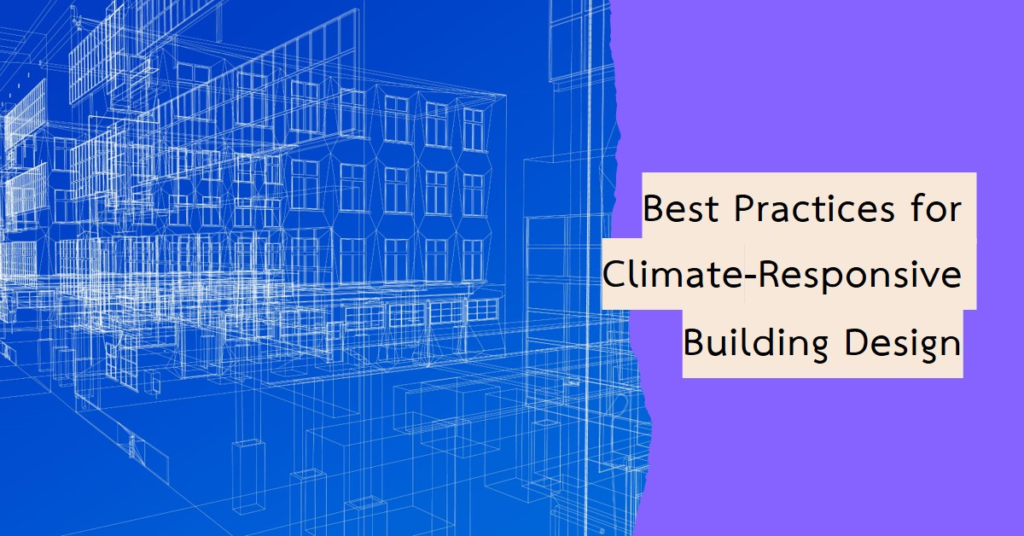
Table of Contents
- Introduction:
- Understanding Local Climatic Conditions
- Building Orientation and Layout
- Passive Solar Design
- Natural Ventilation and Airflow Management
- Material Selection and Thermal Mass
- Incorporating Green Roofs and Walls
- Case Studies and Examples
Introduction:
Climate-responsive design is an architectural approach that emphasizes the integration of local climatic conditions into building design. As the global climate continues to change, the importance of creating structures that are not only functional but also environmentally attuned has become paramount. Buildings designed with climate responsiveness in mind can significantly reduce energy consumption, enhance indoor comfort, and promote sustainability.
In essence, climate-responsive building design involves tailoring architectural features to the specific climate of a region. This means considering factors such as solar orientation, wind patterns, humidity levels, and temperature fluctuations. By doing so, architects and builders can create designs that minimize the need for artificial heating, cooling, and lighting, leading to more energy-efficient buildings.
For instance, in hot and arid climates, building design might focus on maximizing shade and enhancing natural ventilation to keep interiors cool, while in colder regions, it may involve optimizing solar gain and improving insulation to retain heat. The strategic use of materials that respond well to local weather conditions also plays a crucial role. Materials with high thermal mass, which can absorb and slowly release heat, are particularly beneficial in maintaining stable indoor temperatures.
Moreover, climate-responsive design is not only about energy efficiency; it also contributes to the overall health and well-being of building occupants. Proper ventilation and natural lighting can significantly improve indoor air quality and mental well-being. Additionally, such designs can foster a closer connection between people and their environment, encouraging more sustainable living practices.
In today’s fast-evolving environmental landscape, the need for climate-responsive building design has never been more critical. By thoughtfully considering the local climate, architects and builders can develop structures that not only meet the immediate needs of occupants but also contribute to long-term sustainability and resilience. As we move forward, leveraging these design principles will be essential in addressing the challenges posed by climate change and ensuring a harmonious balance between our built environment and the natural world.
Understanding Local Climatic Conditions
When undertaking any building design project, a thorough understanding of the local climatic conditions is essential. This understanding begins with an in-depth analysis of various weather-related factors including temperature ranges, humidity levels, precipitation patterns, wind directions, and seasonal variations. Each of these elements plays a vital role in shaping the architectural approach and ultimately influences the creation of a climate-responsive structure.
Analyzing temperature ranges helps in determining the appropriate insulation and ventilation strategies to maintain indoor thermal comfort. In regions with high temperature fluctuations, it is critical to choose thermal mass materials that can absorb and store heat, thereby reducing the need for artificial heating or cooling.
Humidity levels are another crucial factor. In areas with high humidity, proper ventilation becomes a priority to prevent issues such as mold growth and material deterioration. Conversely, in low-humidity regions, designers might consider materials that retain moisture and enhance indoor air quality. Precipitation patterns must also be factored into the building design. For instance, abundant rainfall may necessitate the use of water-resistant materials and effective drainage systems.
Wind direction and speed influence various aspects of building design including overall orientation, window placement, and structural integrity. Understanding prevalent wind conditions can help maximize natural ventilation and reduce reliance on mechanical systems while ensuring the building withstands high wind forces.
Finally, seasonal variations bring about changes in the external climate that must be addressed. For example, building designs in areas with cold winters and hot summers should incorporate features catering to both extremes to maintain efficiency and comfort year-round.
Thus, comprehensively analyzing local climatic conditions not only guides the orientation and materials selection but also steers broader design strategies to create resilient and climate-responsive buildings. By integrating this analysis into the planning phase, one can significantly enhance the building’s performance and sustainability.
Building Orientation and Layout
Building design significantly influences how a structure interacts with its environment. One critical aspect is the orientation and layout, which play a crucial role in climate-responsive strategies. Proper orientation can maximize natural light, enhance ventilation, and significantly reduce heating and cooling loads, leading to energy-efficient and comfortable living spaces.
In cold climates, it is essential to orient the building to harness maximum solar gain. Placing larger windows on the southern facade allows for better heat absorption during winter. A compact layout can minimize heat loss, while strategic landscaping with evergreen trees can act as a windbreak to reduce chilling winds.
Conversely, in hot-arid climates, the primary goal is to minimize heat gain. Building orientation should focus on avoiding direct sunlight, which can dramatically increase indoor temperatures. North-south orientation is commonly recommended to reduce exposure to the low angle of the sun. Additionally, designing narrow floor plans can enhance natural ventilation, allowing hot air to escape and cooler air to replace it, thereby improving thermal comfort.
Hot-humid climates present distinct challenges, where controlling humidity and promoting airflow are paramount. Buildings should ideally have a west-east orientation to mitigate the effects of the intense afternoon sun. Elevating the structure on stilts or incorporating large, shaded verandahs can promote airflow under and around the building, which helps reduce indoor humidity levels. Furthermore, incorporating wide overhanging eaves can shield windows and walls from direct sunlight.
In temperate climates, where seasonal variations in temperature are more pronounced, a balanced approach is required. Orienting the building to take advantage of both passive solar heating and natural cooling through cross ventilation is critical. Deciduous trees can provide summer shade, while allowing winter sunlight to penetrate once the leaves fall.
Adopting these climate-specific orientation and layout strategies can significantly enhance the performance and comfort of a building. Through careful consideration of how a building interfaces with its environment, designers and architects can create spaces that are not only aesthetically pleasing but also energy-efficient and climate-resilient.
Passive Solar Design
Passive solar design is a crucial principle in climate-responsive building design that leverages the natural movement of the sun to heat and cool spaces effectively. This approach to design minimizes the need for mechanical systems, thus enhancing energy efficiency and sustainability. Strategic placement of windows is a foundational aspect of passive solar design. South-facing windows, for instance, capture maximum solar radiation during the winter months, while overhangs and shading devices mitigate excessive heat gain in summer.
The concept of thermal mass further enriches passive solar systems. Materials with high thermal mass, such as concrete, brick, or stone, absorb heat during the day and release it gradually when temperatures drop. This process not only maintains a steady indoor temperature but also reduces the need for additional heating and cooling, illustrating a harmonious integration of natural heat management.
Shading devices, including awnings, adjustable louvers, and vegetation like deciduous trees, play a significant role in managing daylight and heat. These elements can block excessive solar penetration during peak summer while allowing ample light and warmth during the winter months. Such versatile designs reduce dependency on artificial climate control systems, thereby conserving energy.
Examples of effective passive solar heating techniques include Trombe walls— which are solid walls with high thermal mass—designed to absorb sunlight and gradually radiate heat inward. On the cooling side, cross-ventilation is employed to harness wind flow, drawing cooler air into the building while expelling warmer air, thus maintaining a comfortable indoor environment.
By incorporating passive solar design principles, building designs can achieve a significant reduction in energy consumption, contributing to environmental sustainability. Integrating these methods requires meticulous planning and an understanding of local climate patterns, but the long-term benefits include enhanced occupant comfort, reduced energy costs, and minimized environmental impact, making passive solar design an indispensable strategy in contemporary architecture.


Natural Ventilation and Airflow Management
In the realm of environmentally conscious building design, leveraging natural ventilation and efficient airflow management is paramount. By integrating principles like cross-ventilation, stack ventilation, and the use of wind catchers, architects can significantly enhance the indoor air quality while simultaneously curbing the energy consumption traditionally associated with mechanical ventilation and cooling systems.
Cross-ventilation, for instance, facilitates the movement of air through strategically placed openings on either side of an indoor space. This technique leverages pressure differences to draw fresh air in and push stale air out, thereby maintaining a healthy indoor environment. Proper implementation of cross-ventilation can reduce reliance on air conditioning systems, thus lowering operational costs and mitigating environmental impact.
Another effective approach is stack ventilation. This method capitalizes on the natural rise of warm air while drawing cooler air in from lower openings. By creating a vertical airflow path through the building, stack ventilation can efficiently regulate thermal comfort levels. This approach is particularly advantageous for multi-story structures, where maintaining consistent indoor climate conditions can be challenging.
A more traditional yet innovative solution lies in the use of wind catchers. These architectural features, often seen in Middle Eastern and Persian Gulf structures, harness prevailing wind currents to direct fresh air into the building. Wind catchers can be complemented with internal courtyards or atriums to facilitate effective ventilation. By integrating such passive cooling strategies in building design, substantial energy savings can be achieved while improving indoor air movement and quality.
In conclusion, natural ventilation and airflow management are critical components of sustainable building design. By employing techniques like cross-ventilation, stack ventilation, and wind catchers, it is possible to create energy-efficient structures that not only promote occupant well-being but also contribute to environmental sustainability. Effective natural ventilation strategies are a testament to innovative and climate-responsive building design that aligns with modern sustainability principles.
Material Selection and Thermal Mass
When it comes to climate-responsive building design, the choice of materials is a critical factor that can significantly influence a structure’s energy efficiency and thermal comfort. Selecting materials with appropriate thermal properties is essential in mitigating the effects of external temperature fluctuations. Materials with high thermal mass, such as concrete, stone, and brick, have the ability to absorb and store heat during the day, releasing it slowly as ambient temperatures drop. This process helps in maintaining a stable indoor temperature, reducing the reliance on heating and cooling systems.
In contrast, the use of materials with reflective surfaces can aid in cooling by reflecting a significant portion of the sun’s rays, thus preventing excessive heat buildup within the building. Reflective roofing materials and light-colored facades are excellent choices for buildings in hot climates as they can substantially lower indoor temperatures and minimize air conditioning loads.
Beyond thermal properties, the environmental impact of building materials plays a crucial role in sustainable design. While assessing thermal mass and reflectivity, it is equally important to consider the life cycle of the materials used. Opting for materials that are locally sourced, recyclable, or have low embodied energy contributes to a reduced carbon footprint. For example, reclaimed wood and recycled metal can offer both aesthetic appeal and environmental benefits, aligning with the principles of green building practices.
The integration of sustainable materials with suitable thermal properties not only enhances energy efficiency but also supports the overall goal of creating eco-friendly and climate-responsive structures. Careful material selection thus serves as a foundational element in achieving a harmonious balance between thermal performance and sustainability in building design.
Incorporating Green Roofs and Walls
In the realm of climate-responsive building design, the integration of green roofs and walls has garnered significant attention due to their multifaceted environmental benefits. These sustainable systems play a crucial role in enhancing building insulation, which results in reduced energy consumption for heating and cooling. By providing an additional layer between the building and external elements, green roofs and walls contribute to maintaining a stable indoor temperature, ultimately improving energy efficiency.
Additionally, green roofs and walls are instrumental in mitigating the urban heat island effect. This phenomenon occurs when urban areas become significantly warmer than their rural surroundings, primarily due to human activities and the prevalence of heat-absorbing materials like concrete and asphalt. By incorporating vegetation through green roofs and walls, buildings can significantly reduce surface and air temperatures, thereby creating cooler, more comfortable urban environments.
Stormwater management is another critical benefit of green roofs and walls. These systems act as natural sponges, absorbing and retaining rainwater. This mitigates the risk of flooding, reduces the strain on urban drainage systems, and prevents the pollution of waterways. The ability of green structures to manage stormwater effectively promotes sustainability and resilience in urban planning.
Moreover, green roofs and walls contribute to enhancing urban biodiversity. They provide habitats for various plant and animal species, especially in dense urban areas where natural green spaces are limited. This fosters a more balanced ecosystem and encourages species diversity. Additionally, these green structures can also improve air quality by filtering pollutants and producing oxygen.
For the successful implementation and maintenance of green roofs and walls, considering certain guidelines is essential. Firstly, selecting suitable plant species that can thrive in the specific climatic conditions is paramount. Regular maintenance, including irrigation, pruning, and monitoring for pests and diseases, ensures the longevity and functionality of these systems. Additionally, considering the structural load-bearing capacity of buildings before installation is critical to ensure safety and durability.
Overall, the integration of green roofs and walls in building design presents a practical and effective approach to achieving climate responsiveness. By improving insulation, reducing urban heat islands, managing stormwater, and promoting biodiversity, these green structures make a substantial contribution to creating sustainable, resilient urban environments.
Case Studies and Examples
Climate-responsive building design is not just a theoretical concept; it has been effectively applied in various structures around the globe. A notable example is the Bosco Verticale in Milan, Italy. Designed to incorporate extensive vertical greenery, this building harnesses the benefits of natural elements for improved air quality, temperature regulation, and biodiversity. The vegetation serves as a natural insulator, reducing the building’s energy consumption while promoting a healthier living environment for its residents. This vertical forest model proves particularly effective in urban settings where space for horizontal green areas is limited.
Another exemplary structure demonstrating climate-responsive principles is the Pearl Academy of Fashion in Jaipur, India. Situated in a hot desert climate, this building uses traditional passive cooling techniques combined with modern technology. The design includes courtyards, water bodies, and shaded walkways that reduce the solar heat gain and promote natural ventilation. The use of locally sourced materials further augments the building’s environmental footprint, making it an excellent example of sustainability in design.
In the colder regions, the Bullitt Center in Seattle, USA, epitomizes energy efficiency and sustainable building design. Known as the greenest commercial building globally, it utilizes photovoltaic panels for energy, a rainwater collection system, and a composting toilet system. The structure’s design intentionally maximizes natural daylight, reducing the need for artificial lighting. These features are crucial for minimizing energy consumption and make the Bullitt Center a model for commercial buildings aiming for zero-net energy performance.
The Alice Springs Desert House in Australia provides a remarkable example of adapting to arid climates. Its design features high thermal mass materials and strategic shading to cool internal temperatures naturally. The integration of solar passive design ensures the building remains comfortable even in extreme weather conditions, highlighting the importance of material selection and architectural strategy in building design.
These examples from different climatic zones illustrate best practices in climate-responsive building design. They serve as equitable models for future projects, proposing that thoughtful and contextual architecture can significantly enhance environmental sustainability and livability.


